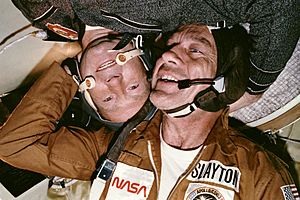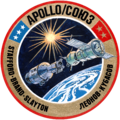Deke Slayton facts for kids
Quick facts for kids
Deke Slayton
|
|
|---|---|
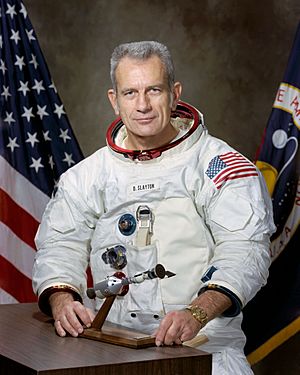
Slayton in 1973
|
|
| Born |
Donald Kent Slayton
March 1, 1924 Sparta, Wisconsin, U.S.
|
| Died | June 13, 1993 (aged 69) League City, Texas, U.S.
|
| Other names | Deke Slayton |
| Alma mater | University of Minnesota (BS) |
| Awards |
|
| Space career | |
| NASA astronaut | |
|
Previous occupation
|
|
| Rank | Major, USAF |
|
Time in space
|
9d 01h 28m |
| Selection | 1959 NASA Group 1 |
| Missions | Apollo–Soyuz Test Project |
|
Mission insignia
|
 |
| Retirement | February 27, 1982 |
| Signature | |
 |
|
Donald Kent "Deke" Slayton (born March 1, 1924 – died June 13, 1993) was an American pilot, engineer, and test pilot. He was chosen as one of the first seven NASA astronauts, known as the Mercury Seven.
Deke Slayton later became NASA's first Chief of the Astronaut Office. This meant he was in charge of picking which astronauts would fly on missions. He flew in World War II as a bomber pilot. After the war, he became an engineer and a test pilot. In 1959, he joined NASA's first group of astronauts.
Slayton was supposed to be the second American to orbit Earth. But in 1962, doctors found he had an irregular heartbeat. This meant he couldn't fly in space for a long time. However, in 1972, he was cleared to fly again! In 1975, he finally went to space on the Apollo–Soyuz Test Project. He helped develop the Space Shuttle program too. Deke Slayton passed away in 1993 at the age of 69.
Contents
Early Life and Military Career
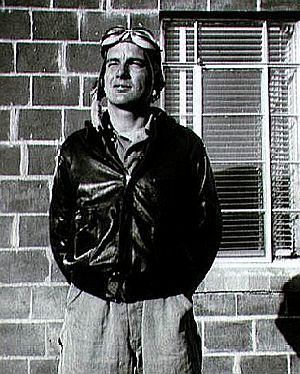
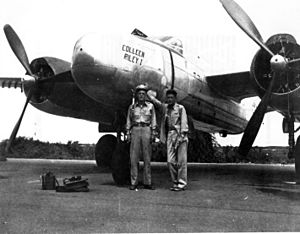
Donald Kent Slayton was born on a farm in Wisconsin on March 1, 1924. His family worked hard, raising sheep and cows. Their home didn't have electricity or indoor plumbing. When he was five, he lost part of his left ring finger in a farm accident.
Deke went to a small two-room school. He graduated from Sparta High School in 1942. He enjoyed boxing and playing the trombone.
World War II Pilot
When the attack on Pearl Harbor happened in 1941, Deke was still in high school. He wanted to join the military. After graduating, he joined the U.S. Army Air Forces to become a pilot.
He trained on different types of planes. Even though he wanted to fly fighter jets, he was chosen to fly larger, multi-engine planes. He learned to fly the B-25 Mitchell bomber.
In 1943, Slayton went to Europe to fly combat missions. He flew over the Balkan Peninsula and Italy. His ships were even attacked by German bombers and submarines. After flying 56 missions, he returned to the U.S. in May 1944.
Soon after, he trained to fly the new A-26 Invader bomber. In July 1945, he went to Okinawa Island in the Pacific. He flew seven missions over Japan. The war ended shortly after, and he returned home. He left the Army in November 1946.
After the War
After the war, Slayton went to the University of Minnesota. He studied aeronautical engineering and graduated in 1949. He then worked as an engineer for Boeing. He helped design planes like the B-52 Stratofortress.
While in college, he joined the Air Force Reserve. Later, he joined the Minnesota Air National Guard. In 1952, he joined the active United States Air Force.
In 1955, Deke Slayton was accepted into the U.S. Air Force Test Pilot School. After graduating, he became a test pilot in California. He tested many different fighter jets, including the F-101, F-102, F-104, F-105, and F-106. He even helped test Britain's first supersonic fighter jet.
NASA Career
Becoming an Astronaut
In 1959, Deke Slayton was chosen as one of the candidates for Project Mercury. This was America's first program to send people into space. He wasn't very interested in space at first, but he decided to try out.
After many tests, Slayton was officially selected as an astronaut on April 2, 1959. He moved his family to be near other astronauts.
During training, doctors found that Deke had an irregular heartbeat, called atrial fibrillation. Even though he felt healthy, NASA worried about his heart in space. In March 1962, just two months before his planned space flight, he was removed from the mission. This was a big disappointment for him.
Leading the Astronauts
After being grounded, Slayton took on a very important job at NASA. He became the senior manager of the astronaut office. This meant he was in charge of choosing new astronauts. He also decided which astronauts would fly on which missions. He was like the "boss" of all the astronauts.
He created a system where astronauts would first be a backup crew for a mission. Then, a few missions later, they would become the main crew. This helped astronauts get experience and prepare for their flights.
Deke Slayton was very involved in the Apollo program. He helped assign the crews for the Gemini and Apollo missions. He even made the final decision for the crew of Apollo 11, which was the first mission to land on the Moon. He chose Neil Armstrong, Buzz Aldrin, and Michael Collins for this historic flight.
Return to Space
Deke Slayton never gave up on his dream of flying in space. He exercised regularly and tried different things to improve his health. After many years and many doctor visits, his heart condition improved.
On March 13, 1972, NASA announced that Deke Slayton was cleared to fly in space again! This was a huge moment for him after being grounded for ten years.
Apollo-Soyuz Mission
In February 1973, Slayton was chosen for the Apollo–Soyuz Test Project (ASTP). This was a special mission where American and Soviet spacecraft would meet and connect in space. He trained for two years, even learning Russian.
The Apollo and Soyuz spacecraft launched on July 15, 1975. Two days later, they met in orbit. The American astronauts, including Deke Slayton, met the Soviet cosmonauts. This was a historic moment of cooperation between the two countries.
When they returned to Earth, some fumes entered the cabin. The crew was hospitalized for a short time as a precaution. At 51 years old, Deke Slayton was the oldest astronaut to fly in space at that time.
Space Shuttle Program

Before his space flight, Slayton also helped manage the early tests for the Space Shuttle program. He helped develop the tests for the Space Shuttle Enterprise. He also helped create the special plane that carries the Space Shuttle.
Deke Slayton officially retired from NASA in 1980. But he still helped out, flying a chase plane during the landing of the second Space Shuttle mission, STS-2. He formally left NASA in February 1982. He had flown over 7,000 hours in various aircraft.
After NASA
After leaving NASA, Deke Slayton became the president of a company called Space Services Inc. This company aimed to launch rockets for private businesses. He was the mission director for the Conestoga rocket. In 1982, it became the first privately funded rocket to reach space.
Slayton also became interested in air racing. He held leadership roles in air racing organizations. He also served on a government committee about commercial space travel.
In 1991, Deke Slayton started writing his autobiography, Deke!: U.S. Manned Space from Mercury to the Shuttle. It was published in 1994, after he passed away. He also co-wrote another book called Moon Shot: The Inside Story of America's Race to the Moon with Alan Shepard.
Personal Life
Deke Slayton married Marjorie Lunney in 1955. They had one son, Kent Sherman. They later divorced in 1978. In 1983, he married Bobbie Belle Jones, who also worked at NASA. They were married until his death.
When Slayton was a test pilot, another pilot was also named Don. To avoid confusion on the radio, Slayton was called "D.K." which became "Deke."
In 1992, Deke Slayton was diagnosed with a brain tumor. He passed away on June 13, 1993, at his home in Texas, at the age of 69.
Awards and Honors
Deke Slayton received many awards for his service and achievements.
Some of his military and NASA awards include:
- Distinguished Flying Cross
- Air Medal
- NASA Distinguished Service Medal
- NASA Exceptional Service Medal
- NASA Outstanding Leadership Medal
- NASA Space Flight Medal
- Campaign Medals for his service in World War II
He also received many honors from different organizations:
- In 1972, he received the James H. Doolittle Award.
- In 1975, he received the National Institute of Social Sciences Gold Medal.
- In 1976, he received the FAI Yuri Gagarin Gold Medal.
- He also received the Collier Trophy, a very prestigious aviation award.
- He received honorary doctorates from several colleges.
Deke Slayton was a member of many professional groups and associations. He was inducted into several Halls of Fame:
- United States Astronaut Hall of Fame (1990)
- International Space Hall of Fame (1990)
- National Aviation Hall of Fame (1996)
- International Air & Space Hall of Fame (2001)
Several places and things have been named in his honor:
- The Texas Oncology-Deke Slayton Cancer Center in Webster, Texas.
- A main road in League City, Texas, was renamed Deke Slayton Highway.
- The Deke Slayton Memorial Space & Bicycle Museum in Sparta, Wisconsin.
- An annual air show in La Crosse, Wisconsin, called the Deke Slayton Airfest.
- Two cargo spacecraft that flew to the International Space Station were named S.S. Deke Slayton and S.S. Deke Slayton II.
- A new communication device for the International Space Station is being developed and named the Slayton Space Communicator (SC-Slayton).
In Media
Deke Slayton has been shown in many films and TV series:
- 1983 film The Right Stuff – played by Scott Paulin
- 1995 film Apollo 13 – played by Chris Ellis
- 1996 TV movie Apollo 11 – played by Jack Conley
- 1998 TV miniseries From the Earth to the Moon – played by Nick Searcy
- 2009 TV movie Moonshot – played by Nigel Whitmey
- 2015 TV series The Astronaut Wives Club – played by Kenneth Mitchell
- 2016 film Hidden Figures – played by Evan Holtzman
- 2018 film First Man – played by Kyle Chandler
- 2019 TV series For All Mankind – played by Chris Bauer
- 2020 Disney+/National Geographic miniseries The Right Stuff - played by Micah Stock
Images for kids
See also
 In Spanish: Deke Slayton para niños
In Spanish: Deke Slayton para niños



